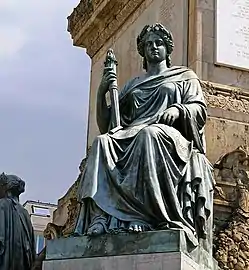Congress Column
The Congress Column (French: Colonne du Congrès, Dutch: Congreskolom) is a monumental column situated on the Place du Congrès/Congresplein in Brussels, Belgium, which commemorates the creation of the Constitution by the National Congress of 1830–1831. It was erected between 1850 and 1859, on the initiative of Charles Rogier according to a design by Joseph Poelaert, and was inspired by Trajan's Column in Rome.[1] At the top of the column is a statue of Belgium's first monarch, King Leopold I, and the pedestal is surrounded by statues personifying the four freedoms guaranteed under the Constitution, while the Belgian Tomb of the Unknown Soldier lies at the foot of the column.
| Congress Column | |
|---|---|
| French: Colonne du Congrès Dutch: Congreskolom | |
 Front view of the Congress Column | |
| Location | Place du Congrès / Congresplein B-1000 City of Brussels, Brussels-Capital Region, Belgium |
| Coordinates | 50°51′0″N 4°21′48″E |
| Area | 1.63 a (1,750 sq ft) |
| Elevation | 47 m (154 ft) |
| Inaugurated by | King Leopold I |
| Built | 1850–1859 |
| Built for | Commemoration of the National Congress of Belgium |
| Restored | 2008 |
| Architect | Joseph Poelaert |
| Architectural style(s) | Neoclassicism (Victory column in Corinthian style) |
| Owner | Belgian government |
This site is served by the Brussels-Congress railway station, as well as by the metro stations Parc/Park and Botanique/Kruidtuin.
History
The first stone was laid down in presence of King Leopold I on 24 September 1850[2] and the monument was inaugurated on 26 September 1859.[3] In 1929, the Congress Column was the site of an attempted assassination of Crown Prince Umberto of Italy by Fernando de Rosa.
The Congress Column was restored from 2002 to 2008.[4]
Description
The Congress Column has a total height of 47 m (154 ft).[5] A spiral staircase of 193 steps inside the column leads to a platform, decorated with a lavishly carved balustrade, surrounding the pedestal of the statue of King Leopold I.[6] The platform can accommodate 16 visitors but is no longer accessible for security reasons. The statue of Leopold was made by Guillaume Geefs.
The important dates in the struggle for Belgian independence are engraved on the pedestal of the column, together with the names of the members of the National Congress and the Provisional Government, and important passages from the liberal Belgian constitution of 1832.
 Pedestal of the Congress Column
Pedestal of the Congress Column Statue of King Leopold I at the top of the column
Statue of King Leopold I at the top of the column Detail of the carving on the column
Detail of the carving on the column
The four sitting statues surrounding the pedestal represent the major constitutional liberties; the 'Freedom of Association' by Charles Fraikin, the 'Freedom of Worship' by Eugène Simonis, the 'Freedom of the Press' and the 'Freedom of Education' both by Joseph Geefs.[7] Two monumental bronze lions by Eugène Simonis are placed in front of the monument.[8] In 2007, during Storm Kyrill, the statue of 'Liberty of the Press' was blown down and later restored.
- Congress Column sculptures
 Liberté de l'enseignement ("Freedom of Education")
Liberté de l'enseignement ("Freedom of Education").jpg.webp) Liberté d'association ("Freedom of Association")
Liberté d'association ("Freedom of Association").jpg.webp) Liberté de culte ("Freedom of Worship")
Liberté de culte ("Freedom of Worship") Liberté de la Presse ("Freedom of the Press")
Liberté de la Presse ("Freedom of the Press")
Monument to the Unknown Soldier

As a memorial to the Belgian victims of World War I, an unknown soldier was buried at the foot of the monument on 11 November 1922. This unknown soldier was selected out of five unidentified soldiers from different battle sites by Raymond Haesebrouck, a veteran blinded in battle.[9] The tomb is surmounted by an eternal flame.
After World War II, a second memorial plaque was added to the monument to honour the Belgian victims. In 1998, a third memorial plaque was dedicated to the Belgian soldiers killed in the service of peace since 1945.
See also
- Neoclassical architecture in Belgium
- July Column, Paris (1835–40)
- Nelson's Column, London (1840–43)
References
Notes
- Stappaerts 1860, p. 45.
- Stappaerts 1860, p. 91.
- Stappaerts 1860, p. 71.
- Régie des Bâtiments (10 April 2009). "Colonne du Congrès". regiedesbatiments.be (in French). Archived from the original on 1 February 2014. Retrieved 26 January 2014.
- Stappaerts 1860, p. 6.
- Stappaerts 1860, p. 43.
- Stappaerts 1860, p. 37.
- Stappaerts 1860, p. 44.
- "Un grand bourgmestre et la ville qu'il aima" (in French). Europeana. 1939. Retrieved 2014-01-28.The oldest film material in this movie (9:03 - 9:49 min), is about the burial of the coffin of the Unknown Soldier at the monument to the Congress Column on November 11, 1922.
Bibliography
- Stappaerts, Félix (1860). La colonne du Congrès à Bruxelles: notice historique et descriptive du monument (in French). Brussels: Van Buggenhoudt.CS1 maint: ref=harv (link)